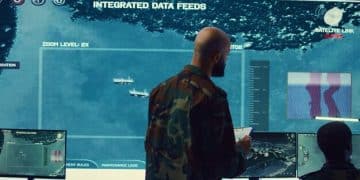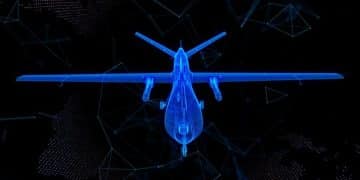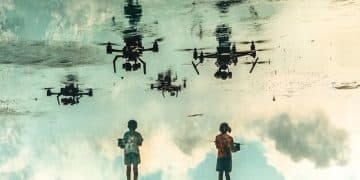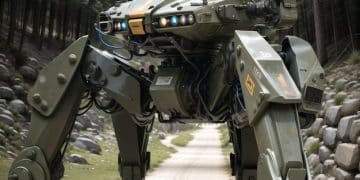AI’s Impact on US Military Drone Tech by 2025: A Deep Dive
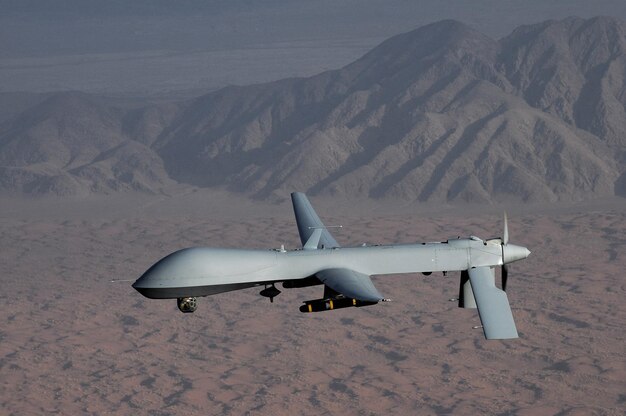
The integration of artificial intelligence is fundamentally reshaping US military drone technology by 2025, enhancing autonomy, precision, and operational efficiency across a spectrum of defense applications from reconnaissance to independent targeting capabilities.
The landscape of modern warfare is undergoing a profound transformation, driven by an accelerating pace of technological innovation. Among these advancements, the convergence of artificial intelligence (AI) and unmanned aerial vehicles (UAVs), commonly known as drones, stands out. So, how is Artificial Intelligence Transforming US Military Drone Technology in 2025?
The Dawn of Autonomous Decision-Making
The notion of drones operating with significant autonomy, once confined to science fiction, is rapidly becoming a reality within the US military. This isn’t merely about pre-programmed flight paths; it involves systems capable of real-time analysis, adaptive mission planning, and even independent target engagement, albeit with varying degrees of human oversight. The push towards greater autonomy is often driven by the need to operate in contested environments where communication links might be jammed or severed, or where human response times are insufficient.
Enhanced Sensor Fusion and Data Analysis
At the heart of autonomous drone operations lies the ability to interpret vast amounts of data from multiple sensors. AI algorithms are designed to fuse inputs from electro-optical, infrared, radar, and signals intelligence payloads, creating a cohesive and comprehensive picture of the operational environment. This fusion allows drones to differentiate between combatants and non-combatants, identify specific threats, and even predict enemy movements with a higher degree of accuracy than human operators alone might achieve. The sheer volume of data collected by modern drones would overwhelm human analysts, making AI not just an enhancement but a necessity for effective use.
- Real-time threat assessment through AI-driven pattern recognition.
- Improved target discrimination in complex urban or cluttered environments.
- Predictive analytics for anticipating adversary actions based on observed data.
- Automated anomaly detection beyond human cognitive limits.
From Piloting to Mission Command
The traditional role of a drone pilot is evolving. While human control remains paramount in many scenarios, AI is shifting the human role towards mission command, oversight, and intervention, rather than direct stick-and-rudder piloting. AI-powered interfaces are simplifying complex tasks, allowing operators to manage swarms of drones or supervise multiple sophisticated missions simultaneously. This paradigm shift frees up human cognitive resources for higher-level strategic thinking, ethical considerations, and rapid decision-making in unforeseen circumstances. The goal is to augment human capabilities, not replace them entirely, by offloading routine or computationally intensive tasks to intelligent systems.
Revolutionizing Reconnaissance and Surveillance
For decades, drones have been invaluable assets for intelligence, surveillance, and reconnaissance (ISR) missions. AI is now taking these capabilities to an unprecedented level, transforming raw sensor data into actionable intelligence with speed and precision previously unimaginable. The ability to autonomously identify, track, and report on targets across vast areas provides a significant strategic advantage, enabling more informed decision-making on the battlefield.
Persistent and Covert ISR Operations
AI-enabled drones can conduct persistent surveillance for extended periods, monitoring areas of interest without requiring continuous human attention. Their ability to adapt their flight paths, vary sensor modes, and even camouflage themselves through advanced material science and AI-driven signature management makes them increasingly difficult to detect and counter. This covert persistence provides a continuous flow of intelligence, critical for tracking high-value targets or monitoring dynamic situations. The algorithms can learn to distinguish between normal activity and suspicious patterns, flagging only relevant events for human review, thus dramatically reducing the data burden.
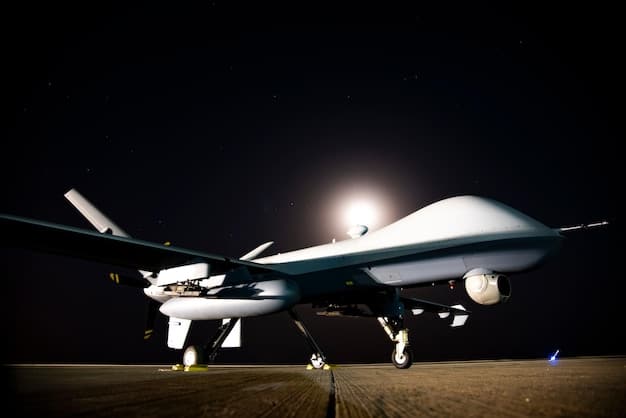
Advanced Object Recognition and Tracking
One of the most immediate impacts of AI in ISR is its capacity for advanced object recognition and tracking. Deep learning models, trained on extensive datasets of military hardware, personnel, and infrastructure, can identify specific vehicles, weapons systems, or individuals with a high degree of certainty, even in challenging conditions like adverse weather or camouflage. Furthermore, AI can track multiple objects simultaneously across different sensor feeds, maintaining a consistent chain of custody and providing continuous situational awareness. This enables rapid identification of new threats or changes in enemy disposition, offering commanders timely and accurate intelligence critical for mission success.
Enhanced Targeting and Precision Strike Capabilities
The integration of AI into US military drones extends far beyond reconnaissance, directly influencing targeting and precision strike operations. While ethical and legal debates around “killer robots” are ongoing, the technological pathways for AI to significantly enhance targeting accuracy and reduce collateral damage are clear and are being actively pursued. The challenge lies in embedding human-in-the-loop decision-making while leveraging AI’s speed and analytical prowess.
Swarming AI for Collaborative Engagement
A burgeoning area of AI application is the development of drone swarms capable of collaborative engagement. Instead of individual drones, AI can orchestrate dozens or even hundreds of drones to operate as a single, distributed sensor and effector network. This collective intelligence allows for overwhelming adversary defenses, dynamic target allocation, and multi-faceted attacks from various vectors. If one drone is lost, the AI autonomously reassigns its mission to others in the swarm, maintaining operational coherence. This distributed resilience makes swarms far more robust than single, high-value assets.
- Coordinated attack patterns using autonomous pathfinding.
- Target distribution among multiple platforms for efficiency.
- Dynamic re-tasking based on real-time battle damage assessment.
- Adaptive counter-swarm capabilities for defensive operations.
Predictive Analysis for Target Prioritization
AI algorithms are becoming adept at predictive analysis, assessing the potential impact of striking different targets based on historical data, real-time intelligence feeds, and understanding of enemy doctrine. This allows for intelligent target prioritization, where AI can suggest the most valuable targets to kinetic strike platforms based on an assessment of their strategic or tactical importance at a given moment. This capability moves beyond static target lists, enabling dynamic optimization of strike operations in fluid combat environments and potentially reducing the ‘fog of war’ by offering clearer, data-driven options.
Logistics and Maintenance Automation
Beyond direct combat roles, AI is significantly improving the logistical backbone and maintenance procedures for the vast US military drone fleet. This transformation enhances operational readiness, reduces costs, and extends the lifespan of these valuable assets, ensuring drones are available when and where they are needed most. The integration of AI in these support functions is often less visible but equally critical for overall effectiveness.
Predictive Maintenance and Diagnostics
Traditional drone maintenance relies heavily on scheduled checks and reactive repairs. AI-driven predictive maintenance utilizes sensor data from drone components—engines, cameras, communication systems—to anticipate failures before they occur. Machine learning algorithms analyze patterns in operational data to predict when a component is likely to fail, allowing for proactive maintenance and parts replacement. This minimizes unscheduled downtime, reduces the likelihood of mission failure due to mechanical issues, and optimizes the use of maintenance resources and spare parts inventories.
Automated Resupply and Logistics
AI is also being explored for automating resupply and logistics for drone operations in austere environments. Autonomous ground vehicles or larger cargo drones, guided by AI, could deliver fuel, spare parts, and other consumables to forward-deployed drone units without human intervention. AI can optimize supply routes, manage inventory levels, and adapt to changing logistical demands, significantly reducing the human footprint in hazardous zones and improving the overall efficiency of drone deployment and sustainment. This includes everything from managing battery charging cycles to ensuring specialized payloads are available.
Challenges and Ethical Considerations
As AI’s role in US military drone technology expands, so do the complex challenges and ethical considerations. The rapid pace of technological advancement demands robust frameworks for accountability, the navigation of complex decision-making scenarios, and ongoing debate about the boundaries of AI autonomy in lethal systems. Addressing these issues is as critical as the technological development itself to ensure responsible and ethical deployment.
Data Security and Cyber Vulnerabilities
The extensive reliance on AI in drones generates and processes immense volumes of sensitive data, making data security a paramount concern. AI systems, like any complex software, are vulnerable to cyberattacks, including data exfiltration, system manipulation, or denial-of-service attacks. Adversaries could seek to corrupt AI training data, insert malicious code, or take control of autonomous systems. Protecting these AI-enabled platforms requires continuous investment in advanced cybersecurity measures, encryption, and resilient network architectures to safeguard against both nation-state actors and sophisticated non-state threats.
Ensuring Human Oversight and Accountability
The debate around “human-in-the-loop,” “human-on-the-loop,” and “human-out-of-the-loop” lethal autonomous weapons systems is central to the ethical discussion. While AI can enhance efficiency, the ultimate responsibility for lethal force must remain with humans. Establishing clear lines of accountability for decisions made by AI systems is complex but crucial. This involves developing ethical guidelines, robust testing protocols, and legal frameworks that ensure human commanders maintain meaningful control and can be held accountable for the actions of AI-enabled systems. The emphasis is on augmentation, not abdication, of human judgment in critical situations.

Addressing Algorithmic Bias and Explainability
AI systems are only as unbiased as the data they are trained on. If training datasets contain biases—for example, if they disproportionately represent certain demographics or operational environments—the AI may perpetuate or even amplify those biases in its decision-making. This could lead to unintended or unjust outcomes. Furthermore, the “black box” nature of some advanced AI models, where it is difficult to understand how a decision was reached, poses challenges for accountability and trust. Research into explainable AI (XAI) is critical to developing systems where the reasoning behind AI decisions can be understood and audited, ensuring transparency and trust in military applications.
The Road Ahead: Integration and Future Capabilities
Looking beyond 2025, the integration of AI into US military drone technology will continue to accelerate, leading to even more sophisticated and interconnected systems. The focus will shift towards seamless integration across joint domains, developing truly cognitive AI capabilities, and adapting to an increasingly complex and contested global security environment. The future battlefield will undoubtedly be shaped by these evolving AI-drone synergies.
Seamless Integration Across Joint Domains
The future of military AI and drones will not be confined to air operations. The emphasis will be on seamless integration across land, sea, air, space, and cyber domains. AI-enabled drones will serve as crucial nodes in a vast, interconnected network, sharing real-time intelligence and coordinating actions with ground forces, naval assets, and space-based platforms. This multi-domain integration, often referred to as Joint All-Domain Command and Control (JADC2), aims to create a cohesive and highly responsive fighting force where information flows freely and decisions are made at machine speed, leveraging AI at every point of interaction.
Cognitive AI and Human-Machine Teaming
The next frontier involves the development of cognitive AI for drones—systems that can not only process data and execute tasks but also understand context, learn from experience, and even anticipate human intent. This will lead to more sophisticated human-machine teaming, where AI-enabled drones act as true teammates, anticipating human needs, offering proactive solutions, and seamlessly collaborating on complex missions. Such cognitive capabilities will allow drones to operate with greater independence and adaptability in ambiguous or rapidly changing situations, pushing the boundaries of what autonomous systems can achieve in support of human operators. This will require significant breakthroughs in machine learning, natural language processing, and robust AI architectures that are capable of handling extreme adversarial conditions.
| Key Point | Brief Description |
|---|---|
| 🚀 Autonomous Decision-Making | AI-enabled drones gain enhanced real-time analysis, adaptive mission planning, and even independent targeting. |
| 🛰️ ISR Transformation | AI drives advanced object recognition, persistent surveillance, and actionable intelligence from drone data. |
| 🎯 Enhanced Targeting Precision | AI enables swarming tactics, predictive analysis for target prioritization, and reduced collateral damage. |
| ⚖️ Ethical & Security Challenges | Navigating data security, ensuring human oversight, and addressing algorithmic bias are critical. |
Frequently Asked Questions about AI in Military Drones
The primary impact of AI on US military drones by 2025 is a significant enhancement in their autonomy, enabling more complex decision-making, improved data analysis in real-time, and a shift towards human oversight rather than continuous direct human control, accelerating mission execution and effectiveness across various operations.
AI improves drone reconnaissance and surveillance by enabling advanced object recognition, persistent monitoring without constant human intervention, and the ability to fuse vast sensor data into actionable intelligence. This leads to faster, more accurate identification and tracking of targets, even in challenging environmental conditions, transforming raw data into critical insights efficiently.
While AI significantly increases drone autonomy, US military doctrine generally maintains a human-in-the-loop or human-on-the-loop approach for lethal decision-making. This means that while AI assists in targeting and mission execution, a human operator retains ultimate authority to authorize the use of lethal force, balancing efficiency with ethical considerations and accountability.
Key ethical concerns include ensuring human accountability for AI-driven decisions, preventing algorithmic bias that could lead to unfair or inaccurate targeting, and securing AI systems against cyber vulnerabilities that could compromise their integrity or lead to unintended consequences. These issues necessitate robust ethical frameworks and continuous oversight in development and deployment.
AI significantly impacts drone maintenance and logistics through predictive analytics, which anticipate mechanical failures before they occur, reducing unscheduled downtime and optimizing spare parts management. It also enables automated resupply and logistics operations, reducing human exposure in hazardous areas and improving overall fleet readiness and operational efficiency through optimized resource allocation.
Conclusion
The integration of artificial intelligence is fundamentally redefining US military drone technology moving into 2025, pushing the boundaries of what is possible in intelligence gathering, precision strike, and logistical support. From enabling more autonomous decision-making and enhancing reconnaissance capabilities to transforming maintenance schedules, AI is proving to be a force multiplier. While significant technological advancements are undeniable, equally important are the ongoing dialogues around ethical deployment, human oversight, and cyber resilience. As these sophisticated systems evolve, striking a balance between technological prowess and responsible governance will be paramount in shaping the future of military operations.
